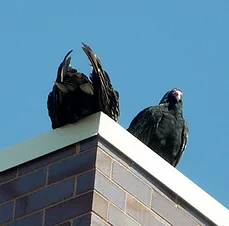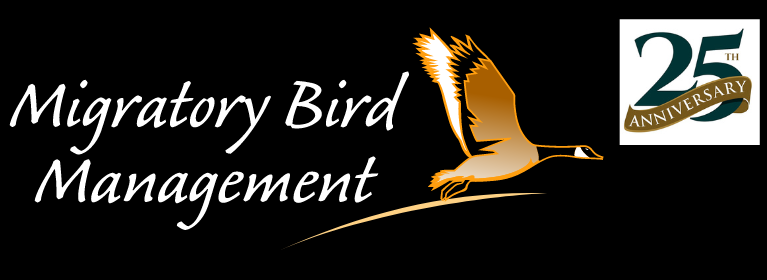
APPEARANCE
Turkey Vultures are a large, nearly eagle sized shiny dark bird with a naked head. While the body, tail and neck are black, flight feathers are a dark silver and back feathers are a dark bronze. Adult birds have a red head, juveniles have a dark gray head. From afar, they often look solid black. They have a large wingspan with feathers that separate at the end like fingers. They soar in a distinctive teetering “V” shape that is diagnostic for identification.
BEHAVIOR
Turkey Vultures will roost and migrate in large groups. They are generally not shy when it comes to humans or their structures and can often be seen warming up, cooling off, and generally loitering on tall buildings or utility poles. They will defecate on their legs to keep themselves cool in hot environments and will vomit a foul mix of rotting food and strong stomach acid as a defense mechanism against potential predators.
DIET
Turkey Vultures are scavengers and eat carrion. This can include both freshly dead animals and decomposing animals. They also frequent landfills. They will rarely take live prey, usually only when no other food is available and the prey is already compromised by injury or illness. The extreme acidity of their digestive system helps break down diseases and parasites they ingest from their diet of rotting meat. Unlike most other birds, Turkey Vultures have an amazing sense of smell to help them find their food.
HABITAT
Outside of the breeding season, Turkey Vultures will roost in large groups on any open area. They appreciate tall buildings and poles in urban areas. Open areas and broken forest areas, farmland, and other areas that promote soaring flight while searching for food. Turkey Vultures are native to the US and protected by the Migratory Bird Treaty Act of 1918.
NESTING
Turkey Vultures prefer to nest in rock crevices, abandoned heron nests, overhangs, ledges, animal burrows or small caves, be they natural or man-made. Pairs are monogamous, have their own nesting territory, and may use the same nesting spot sometimes for decades. While they are very comfortable loitering and feeding in urban areas close to humans, they prefer to nest in more secluded areas.
MIGRATION
Turkey Vultures migrate in large flocks, sometimes numbering in the thousands. They tend to soar from thermal to thermal circling up and then gliding rather than actively flapping. They live year round in areas as far north as the southern tip of Illinois.
ISSUES CAUSED BY TURKEY VULTURES
- Droppings are very acidic and quickly cause damage to structures
- Droppings rapidly create a large and foul mess on structures and properties
- Turkey Vultures have been known to actively seek out and pull out rubber seals around windows and grout between tiles
- Scratching and pulling out weather stripping on vehicles and boats
- Their size, appearance, and diet often makes people afraid or uncomfortable with their presence
- Their soaring flight and preference for open areas causes risk for bird strikes with aircraft
HOW TO MANAGE ISSUES WITH TURKEY VULTURES
- Exclude vultures from loitering by blocking off perching areas
- Structural deterrents to make loitering areas uncomfortable or unwelcoming to vultures
- Harassment of vultures with canines or lasers
Sources: The Audubon Society, Cornell Lab of Ornithology bird guide, Human Society of the United States, Internet Center for Wildlife Damage Management, Nest Watch


